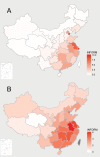The epidemic potential of avian influenza A (H7N9) virus in humans in mainland China: A two-stage risk analysis
- PMID: 31002703
- PMCID: PMC6474630
- DOI: 10.1371/journal.pone.0215857
The epidemic potential of avian influenza A (H7N9) virus in humans in mainland China: A two-stage risk analysis
Abstract
Background: From 2013 to 2017, more than one thousand avian influenza A (H7N9) confirmed cases with hundreds of deaths were reported in mainland China. To identify priorities for epidemic prevention and control, a risk assessing framework for subnational variations is needed to define the epidemic potential of A (H7N9).
Methods: We established a consolidated two-stage framework that outlined the potential epidemic of H7N9 in humans: The Stage 1, index-case potential, used a Boosted Regression Trees model to assess population at risk due to spillover from poultry; the Stage 2, epidemic potential, synthesized the variables upon a framework of the Index for Risk Management to measure epidemic potential based on the probability of hazards and exposure, the vulnerability and coping capacity.
Results: Provinces in southern and eastern China, especially Jiangsu, Zhejiang, Guangzhou, have high index-case potential of human infected with A (H7N9), while northern coastal provinces and municipalities with low morbidity, i.e. Tianjin and Liaoning, have an increasing risk of A (H7N9) infection. Provinces in central China are likely to have high potential of epidemic due to the high vulnerability and the lack of coping capacity.
Conclusions: This study provides a unified risk assessment of A (H7N9) to detect the two-stage heterogeneity of epidemic potential among different provinces in mainland China, allowing proactively evaluate health preparedness at subnational levels to improve surveillance, diagnostic capabilities, and health promotion.
Conflict of interest statement
The authors have declared that no competing interests exist.
Figures



Similar articles
-
Update: Increase in Human Infections with Novel Asian Lineage Avian Influenza A(H7N9) Viruses During the Fifth Epidemic - China, October 1, 2016-August 7, 2017.MMWR Morb Mortal Wkly Rep. 2017 Sep 8;66(35):928-932. doi: 10.15585/mmwr.mm6635a2. MMWR Morb Mortal Wkly Rep. 2017. PMID: 28880856 Free PMC article.
-
Co-circulation of multiple genotypes of influenza A (H7N9) viruses in eastern China, 2016-2017.Arch Virol. 2018 Jul;163(7):1779-1793. doi: 10.1007/s00705-018-3800-3. Epub 2018 Mar 14. Arch Virol. 2018. PMID: 29541846
-
Surveillance of Avian H7N9 Virus in Various Environments of Zhejiang Province, China before and after Live Poultry Markets Were Closed in 2013-2014.PLoS One. 2015 Aug 26;10(8):e0135718. doi: 10.1371/journal.pone.0135718. eCollection 2015. PLoS One. 2015. PMID: 26308215 Free PMC article.
-
[The effects of closure to live poultry markets on Avian influenza A (H7N9) epidemics in China].Zhonghua Liu Xing Bing Xue Za Zhi. 2017 Dec 10;38(12):1716-1718. doi: 10.3760/cma.j.issn.0254-6450.2017.12.027. Zhonghua Liu Xing Bing Xue Za Zhi. 2017. PMID: 29294594 Review. Chinese.
-
Epidemiology, Evolution, and Pathogenesis of H7N9 Influenza Viruses in Five Epidemic Waves since 2013 in China.Trends Microbiol. 2017 Sep;25(9):713-728. doi: 10.1016/j.tim.2017.06.008. Epub 2017 Jul 19. Trends Microbiol. 2017. PMID: 28734617 Review.
Cited by
-
Spatial and temporal clusters of avian influenza a (H7N9) virus in humans across five epidemics in mainland China: an epidemiological study of laboratory-confirmed cases.BMC Infect Dis. 2020 Aug 26;20(1):630. doi: 10.1186/s12879-020-05345-4. BMC Infect Dis. 2020. PMID: 32842978 Free PMC article.
-
Based on the MaxEnt model the analysis of influencing factors and simulation of potential risk areas of human infection with avian influenza A (H7N9) in China.Front Cell Infect Microbiol. 2025 Jan 3;14:1496991. doi: 10.3389/fcimb.2024.1496991. eCollection 2024. Front Cell Infect Microbiol. 2025. PMID: 39831108 Free PMC article.
-
Interleukin-17-A multifaceted cytokine in viral infections.J Cell Physiol. 2021 Dec;236(12):8000-8019. doi: 10.1002/jcp.30471. Epub 2021 Jun 16. J Cell Physiol. 2021. PMID: 34133758 Free PMC article. Review.
-
Risk distribution of human infections with avian influenza A (H5N1, H5N6, H9N2 and H7N9) viruses in China.Front Public Health. 2024 Oct 24;12:1448974. doi: 10.3389/fpubh.2024.1448974. eCollection 2024. Front Public Health. 2024. PMID: 39512713 Free PMC article.
References
-
- Wang X, Jiang H, Wu P, Uyeki TM, Feng L, Lai S, et al. Epidemiology of avian influenza A H7N9 virus in human beings across five epidemics in mainland China, 2013–17: an epidemiological study of laboratory-confirmed case series. The Lancet Infectious Diseases. 2017;17(8):822–32. 10.1016/S1473-3099(17)30323-7 - DOI - PMC - PubMed
MeSH terms
LinkOut - more resources
Full Text Sources
Medical

